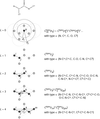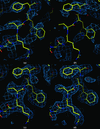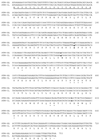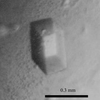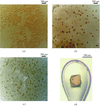issue contents
March 2003 issue

Cover illustration: The water structure in the central core of the T6 human insulin hexamer consists of three layers, separated by approximately 3.2 Å. An extensive hydrogen-bonded network exists within layers 1 and 3 (red and green atoms) that also incorporates the carboxylate groups of the six GluB13 side chains (p. 474).
research papers
The atomic resolution crystal structure of neurotoxin Ts1 has been determined. It provides an explanation for the competition between Ts1 and depressant and excitatory neurotoxins.
PDB reference: neurotoxin Ts1, 1npi, r1npisf
The structure of E. coli L-asparaginase has been determined at 1.95 Å resolution in space group C2. The crystal structure is compared with the previously determined P21 crystal form.
PDB reference: L-asparaginase, 1nns, r1nnssf
The structure of r(GGUCACAGCCC)2 has been determined by X-ray crystallography under a variety of conditions. Crystals of this homoduplex were grown from a mixture of two RNAs which were expected to form a heteroduplex in solution. Given the types and number of mismatches, it is not expected that the observed homoduplex would exist in any appreciable amount in solution, yet it is clearly stable in the crystalline form despite a large number of mismatched base pairs.
The replacement of rG in the 5′ terminus of d(GCGCGCG) does not change either the helical form or the water-structure motifs of the helix.
PDB reference: rGd(CGCGCG), 1m6r, r1m6rsf
Using the force field presented, conditional optimization of three small protein structures against 2.0 Å observed diffraction data shows a large radius of convergence.
Atomic resolution structures of the endoglucanase Cel5A have been determined at various stages along the reaction coordinate.
The crystal structure of the native form of phosphoglucose isomerase from rabbit is presented. Its comparison with four previously determined ligand-bound enzymes reveals conformational changes that are associated with catalytic activity.
PDB reference: rabbit PGI, 1n8t, r1n8tsf
A combinatorial approach was used to identify the optimal lengths of RNA components that provide high-quality crystals of a ribonucleoprotein complex. The technique was applied to the crystallization of the the S. cerevisiae ribosomal protein L30 in complex with the autoregulatory structure in its cognate mRNA.
At 120 K, four residues at the N-terminus of the B chain of monomer 2 undergo a displacement of up to 8 Å.
PDB reference: T6 human insulin, 1mso, r1msosf
Methods are presented that describe the placement of an Cα trace into a protein electron-density map without user intervention.
The Ta6Br cluster compound is a mild derivatization reagent which provides very potent phasing at high resolution owing to its strong anomalous scattering signal.
cluster compound is a mild derivatization reagent which provides very potent phasing at high resolution owing to its strong anomalous scattering signal.
crystallization papers
Lipase 2 from the yeast C. rugosa has been crystallized by the hanging-drop vapour-diffusion method under two different experimental conditions, revealing two different oligomeric states of the enzyme. Native data sets have been collected to resolutions of 2.65 and 1.97 Å.
Three different fragments of human doublecortin-like kinase have been purified. The N-terminal domain has been crystallized and preliminary X-ray data have been obtained.
Partial extracellular fragment of YWK-II protein/APPH related to the Alzheimer βA4-amyloid precursor protein has been expressed in E. coli, crystallized and a complete selenomethionine (Se-Met) derivative data set has been collected at 2.38 Å resolution at ESRF.
The outer-membrane cobalamin transporter BtuB from E. coli has been overexpressed and purified. Trigonal crystals have been obtained of the apo and substrate-bound forms. A native data set has been collected to 2.0 Å using synchrotron radiation.
SP1, a boiling-stable and stress-related protein with no significant sequence homology to other stress-related proteins or small heat-shock proteins, has been crystallized. Diffraction studies of SP1 crystals at low temperature indicated that they belong to the I422 space group, with unit-cell parameters a = 89, b = 89, c = 187 Å.
The nucleotide sequence of the phoN gene of a pathogenic strain of S. enterica sv. Typhimurium, which encodes a non-specific acid phosphatase, exactly matched that of S. enterica sv. Typhi. The PhoN protein of this strain crystallized in a functionally active form in space groups C2 and C2221.
Juvenile hormone-binding protein isolated from haemolymph of the wax moth G. mellonella has been crystallized in two polymorphic forms. The trigonal crystals, grown at neutral pH, with space group P3121 (or P3221) and three molecules in the asymmetric unit, diffract X-rays to 2.7 Å resolution.
Recombinant mung bean cytokinin-specific binding protein has been overexpressed in E. coli and crystallized in complex with zeatin, a plant growth hormone. The crystals belong to the hexagonal system, space group P62 or P64, with multiple copies of the protein in the asymmetric unit, and diffract X-rays to 1.25 Å resolution.
Glycogen synthase is the enzyme that catalyzes the last step in glycogen biosynthesis. Crystals of the enzyme from the bacterium A. tumefaciens have been obtained that diffract to 2.6 Å resolution and belong to space group P21. Selenomethionine has been successfully incorporated, setting the framework for a multiwavelength anomalous diffraction approach.
Crystallization and preliminary X-ray analysis of an alkaline serine protease from Nesterenkonia sp.
A subtilisin-like serine protease from a novel alkaliphilic bacterium, Nesterenkonia sp. AL20, has been crystallized with space group R3 and unit-cell parameters a = b = 92.26, c = 137.88 Å. High-resolution data have been collected to 1.39 Å.
The eukaryotic ATP-dependent phosphofructokinase from T. brucei has been overexpressed, purified and crystallized as the apoenzyme and in complex with ligands.
The potential cell-wall modifying enzyme xyloglucan endotransglycosylase, XET16A, from Populus tremula × tremuloides has been crystallized. Diffraction data were collected from two different crystal forms belonging to space groups P3121/P3221 and P63.
Crystals of bacteriophage PRD1, a virus containing an internal lipid bilayer, have been grown in thin-walled quartz capillary tubes by vapour diffusion as a means of eliminating mechanical handling of the crystals during data collection.
The crystallization of swine vesicular disease virus (SVDV), isolate SPA/2/'93, in three crystal forms and the arrangement of the viral particles within the different unit cells is described.
Here, the cloning, expression, purification and crystallization, as well as preliminary X-ray analysis of C. elegans ubiquitin conjugation enzyme M7.1 is reported.
Purified from the venom of A. acutus, two glycosylated snake venom serine proteinases with high homology of N-terminal amino-acid sequences and distinct carbohydrate contents have been crystallized. Two sets of X-ray diffraction data with the resolutions of 2.3 and 2.1 Å, respectively, have been obtained from the two protein crystals.
A recombinant form of the CTP synthetase from T. thermophilus HB8 has been expressed in E. coli, purified and crystallized. The crystals belong to space group I222 and diffraction data have been collected to 2.25 Å resolution.
The chains of the tetrameric α2β2 P-protein (∼200 kDa) have been coexpressed in E. coli, purified and crystallized as a stable complex. A complete native data set has been collected to 2.4 Å resolution.
Crystals of human sorbitol dehydrogenase were grown from polyethylene glycol solutions and diffracted to 2.75 Å resolution.
Phosphopantetheine adenylyltransferase from H. pylori has been crystallized. X-ray diffraction data have been collected to 2.00 Å resolution.
A putative aspartate aminotransferase (Mj0684 gene product) from M. jannaschii has been crystallized at 296 K. The crystals diffract to 2.2 Å resolution using Cu Kα radiation.
The salt-tolerant glutaminase from M. luteus K-3 has been crystallized by the hanging-drop vapour-diffusion method and preliminary characterization of the crystals is reported.
Tetragonal crystals of chorismate synthase from H. pylori have been obtained (I4, a = b = 145.79, c = 130.98 Å). X-ray diffraction data have been collected to 2.5 Å resolution.
These crystallographic results are the first from any member of the catalytic effector proteins, which are essential components of the large and functionally diverse family of multicomponent monooxygenases. The manuscript documents X-ray diffraction data collected from the native, Se-Met enriched and mutant isoforms.
RecFOR proteins are important for DNA repair by homologous recombination in bacteria. The RecO protein from Thermus thermophilus has been cloned and purified, and its binding to oligonucleotides was characterized.
Cytochrome c′′ from the obligate methylotroph M. methylotrophus has been crystallized under conditions involving the utilization of cadmium chloride as an additive. Addition of glycerol to the crystallization buffer produced crystals suitable for X-ray diffraction, with a reduced solvent content and mosaicity, which diffracted to a maximum resolution of 1.19 Å using synchrotron radiation.
Candoxin, a novel reversible neurotoxin from the Malayan krait B. candidus, was crystallized in space group P6222 with one molecule per asymmetric unit. The crystals diffracted to 1.8 Å.
Crystals of two heptad-repeat (HR) helix bundles of measles virus fusion protein were obtained both in native and SeMet-substituted forms. The crystals diffract X-rays to beyond 2 Å resolution.
The activated fragment of Cry4B endotoxin from B. thuringiensis subsp. israelensis, which is specifically toxic to mosquito larvae, has been purified and crystallized. The crystals belonged to space group R32 and diffracted to 1.75 Å resolution.
Human dipeptidyl peptidase IV has been expressed in the baculovirus system, purified and crystallized.
The production, purification and crystallization of a pocilloporin pigment from a reef-forming coral
This report details the production, purification, crystallization and preliminary diffraction analysis of a blue-coloured pigment from coral.
Crystals of SQR that diffract to 2.6 Å were obtained by rational screening and sample quality analysis using electron microscopy.
short communications
How CHAPS helped crystallization: masking an hydrophobic patch on the protein surface and stabilizing a flexible loop.
The structure of E. coli 2-C-methyl-D-erythritol 4-phosphate cytidylyltransferase in a tetragonal crystal form is presented. Sequence and structure comparisons indicate that the E. coli protein is representative of the enzyme from a number of pathogenic bacteria and is suitable for use in the development of broad-spectrum antibiotics.
The structure of E. coli class II fructose-1,6-bisphosphate aldolase reconstituted with and crystallized in the presence of Cd2+ instead of Zn2+ has been determined. The structure shows both a catalytic and structural divalent cation in the active site at positions consistent with those observed when the zinc enzyme is complexed with a transition-state analogue.
PDB reference: cadmium fructose-1,6-bisphosphate aldolase, 1gyn, r1gynsf
A structural interpretation of Sheldrick's 1.2 Å rule is presented in terms of sinc-function contributions to |E|2 profiles as a function of resolution and of the interferences between characteristic interatomic distances.


 journal menu
journal menu















